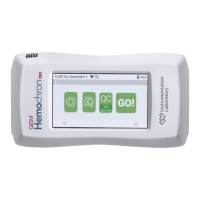4 - Patient Testing
46 / 112
000HZ6006EN.US • 02 • GEM Hemochron 100 Operator Manual
4
Patient Testing
4.1
Considerations About Patient Testing
BIOHAZARD: Running a patient test requires the handling of human blood samples. Strictly adhere to
the institution’s policies for the proper handling and disposal of biohazardous materials.
BIOHAZARD: Test cartridges are for single-use only, do NOT reuse. Used test cartridges should be
considered as potentially infectious. Strictly adhere to the institution’s policies for the proper handling
and disposal of biohazardous materials.
QCLockout:
If patient test lockout is in eect,
Operators
are prevented from running patient tests until the lockout is
cleared. For more information, see
“QC Lockout” (page 53)
.
Test Cartridges:
Only use GEM Hemochron 100 test cartridges. Use the appropriate test cartridge for the type of test that will
be performed. Test cartridges are for single-use only, do NOT reuse.
Patient Samples:
Operators
must not prepare the patient sample until the instrument prompts them to apply the sample to the
test cartridge. If the patient sample is prepared too early, premature clotting could cause erroneous test
results. Refer to the appropriate GEM Hemochron 100 test cartridge package insert.
Test Results:
At the conclusion of the test, when the test results are displayed, an
Operator
can add a user note to the test
result and view details of the test result.
Test results that are within the analytical measurement range of the test are reported as Celite equivalent ACT
value in seconds. The analytical measurement range for each test is a factory default setting and cannot be
changed. Test results that are outside the analytical measurement range of the test are not reported and are
logged as:
● Out of Range Low – The test result is lower than the analytical measurement range.
● Out of Range High – The test result is greater than the analytical measurement range.
If a test result is out of range, “Out of Range High” or “Out of Range Low” should not be interpreted
as a test result and the test needs to be repeated. If the test result is still out of range, see
“Troubleshooting” (page 65)
.
NOTE: Test results are stored in the instrument database. To view them, see “Database” (page 63).
4.2
Specimen Collection
Collect fresh whole blood samples for coagulation testing in accordance with institutional procedures and the
Clinical and Laboratory Standards Institute (CLSI) guideline POCT14‑A ensuring sucient dead space volume
of blood is removed prior to specimen collection, when applicable.
IMPORTANT: Collect blood specimens in a manner that prevents contamination with tissue thromboplastin,
indwelling intravenous (IV) solutions, or alcohol cleansing solution. Discard samples that are not properly
collected or contain visible clots or debris.
Use a 23-gauge or larger needle if a syringe is used for blood collection. If a sample is expelled through the
same needle, do it slowly to prevent hemolysis.
Refer to the package insert accompanying the GEM Hemochron 100 test cartridges for specimen collection,
storage, handling, and disposal instructions.

